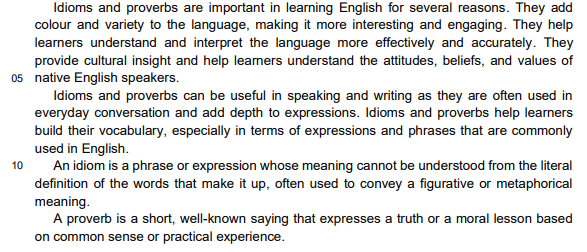Questões de Concurso
Comentadas para funcern
Foram encontradas 4.251 questões
Resolva questões gratuitamente!
Junte-se a mais de 4 milhões de concurseiros!
Text 03 – Idioms and proverbs

From what is briefly explained in text 03, the image below (Picture 01) represents:

(Picture 01 – Illustrastion done by students in a language classroom).
“O processo de desenvolvimento prepara e torna possível um processo específico de aprendizagem. O processo de aprendizado, então, estimula e empurra para a frente o processo de desenvolvimento. [...] O mais importante aspecto novo desta teoria é o amplo papel que ela atribui ao aprendizado no desenvolvimento da criança”. (Vygotsky, 1991)
Com base nessa citação, considerando-se especificamente a apropriação da escrita alfabética, é correto compreender
Letícia aponta para as duas primeiras letras: L (fala VE) – A (fala LA). Olha indecisa as letras que sobraram e resolve apapagá-las. - Tenho de apagar, tá sobrando. A vela é pequena, não precisa de tanta letra. Em seguida, apaga, deixando apenas as duas letras.
Essa situação de aprendizagem mostra que, ainda meio confusa entre a relação da palavra com o objeto e com o número de letras para representá-la, a criança mostra-se capaz de dividir a palavra em segmentos sonoros, as sílabas, indicando, assim, uma habilidade inicial de consciência silábica. Contudo, faz uma correção quantitativa e não qualitativa ao deixar o LA como escrita de VELA. Nesta situação, é correto o entendimento de que essa criança
Analise o fragmento textual a seguir, sobre avaliação da aprendizagem.
“Poderíamos entender alguns preceitos da LDB 9394/96 a partir de tais princípios delineados. Um processo avaliativo mediador é, por sua natureza, preventivo, no sentido de uma atenção constante às dificuldades apresentadas pelos alunos; é cumulativo e não somativo, no sentido de que os dados qualitativos e quantitativos se complementam, permitindo uma análise global do aprendizado do aluno. Dessa forma, a reflexão acerca de tais princípios, pelos professores, para que venham a entender as determinações legais, deveria ser o ponto de partida para a implementação de tais práticas em avaliação”. (HOFFMANN, 1999, pp.36-38).
Considerando o pensamento da autora, explicitado nesse fragmento, um processo avaliativo mediador
está embasado em alguns princípios essenciais de avaliação como